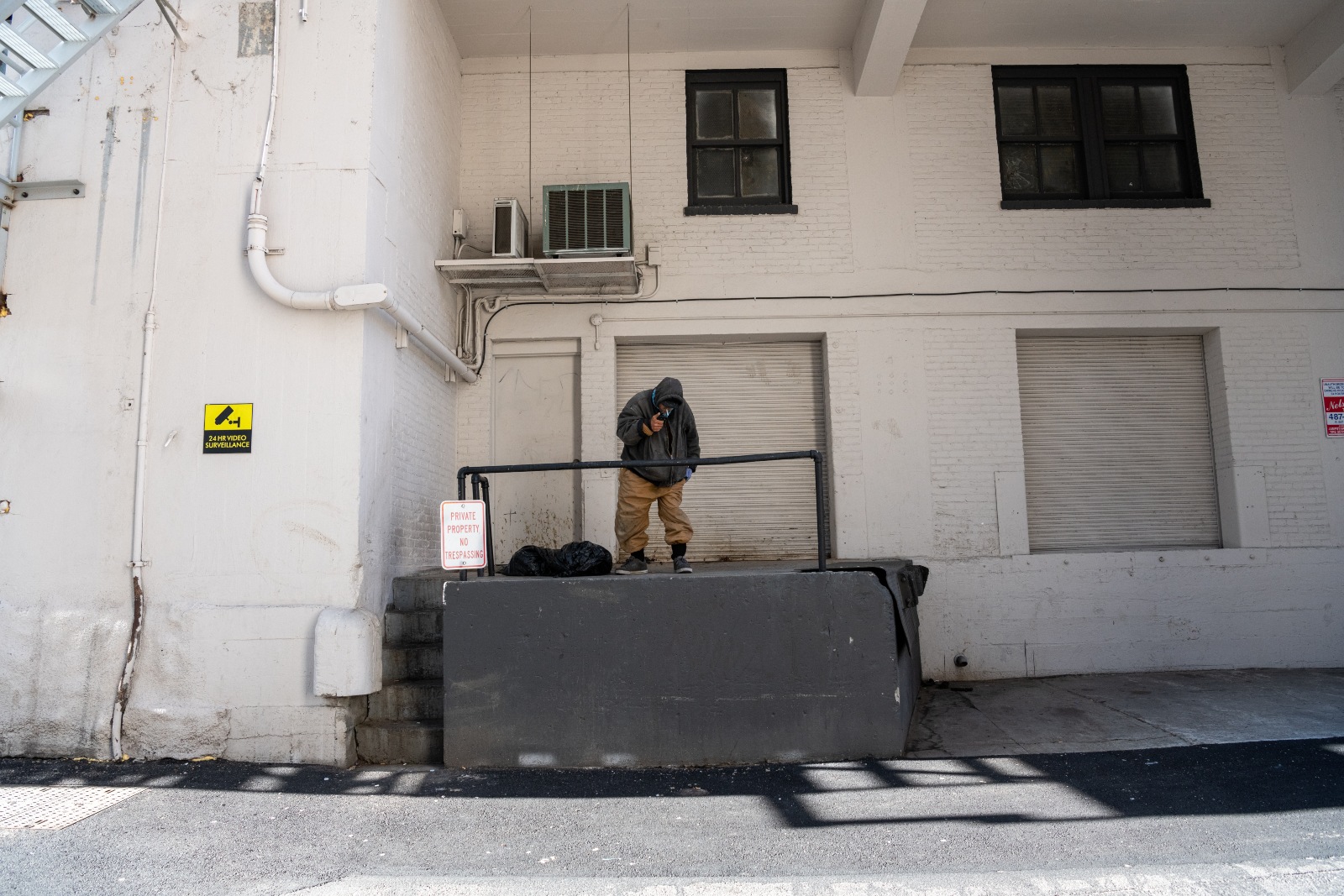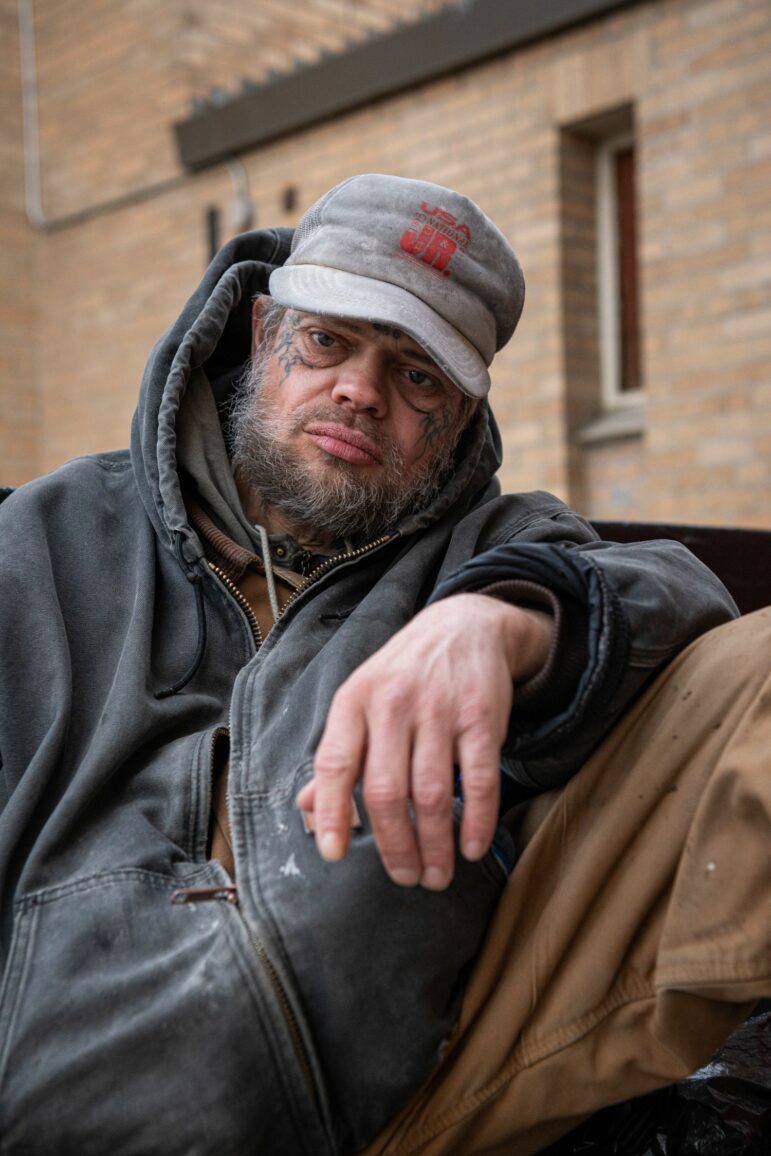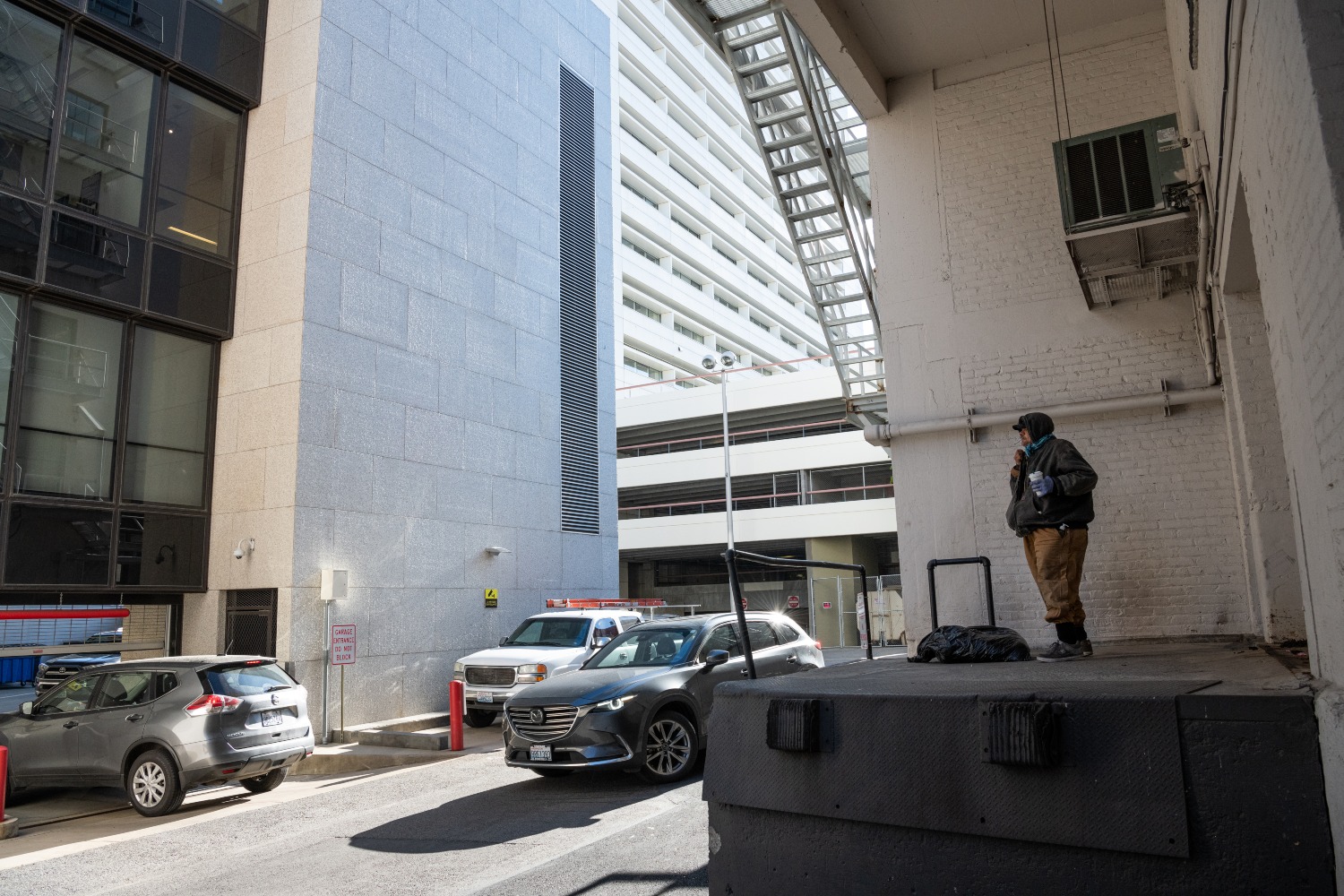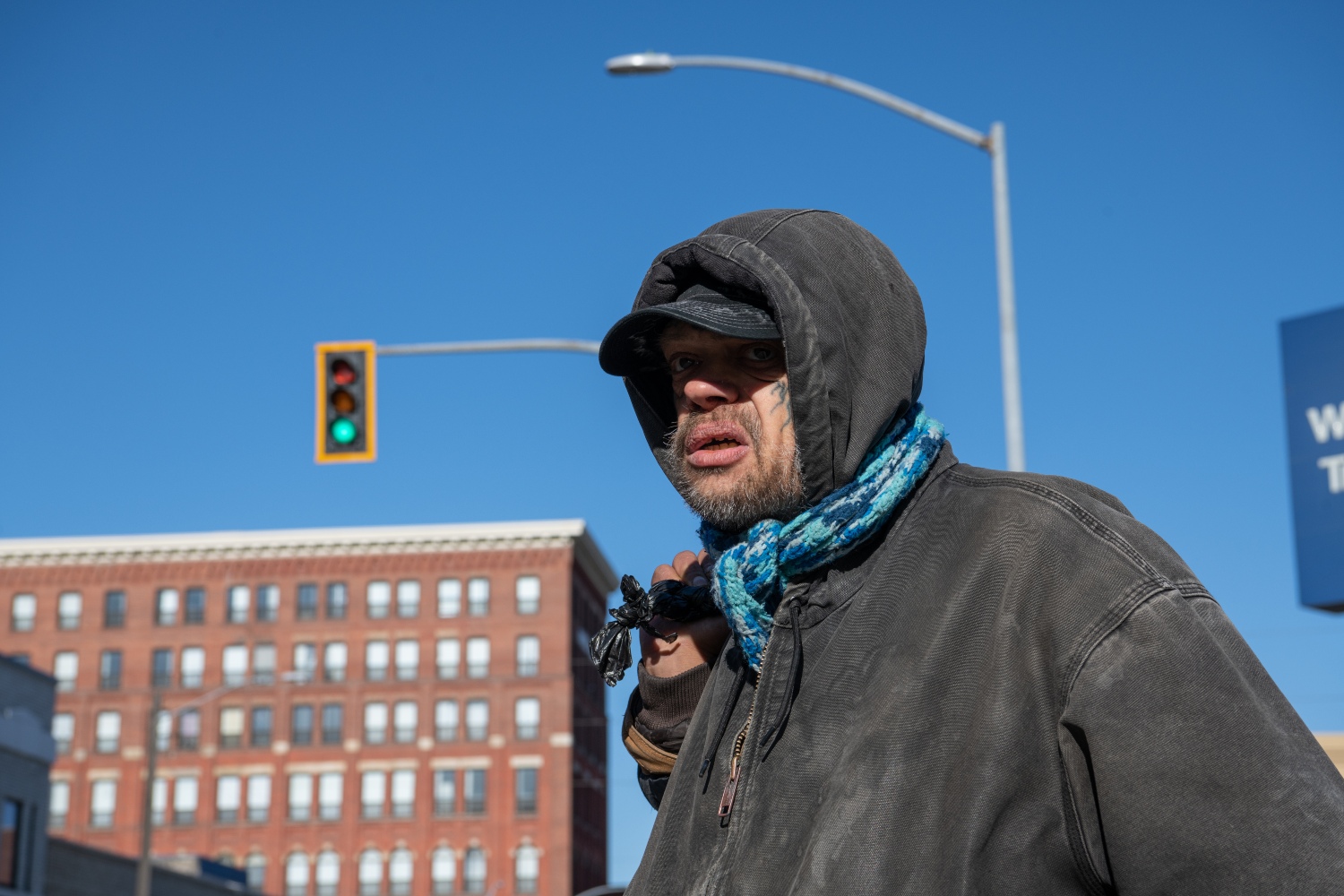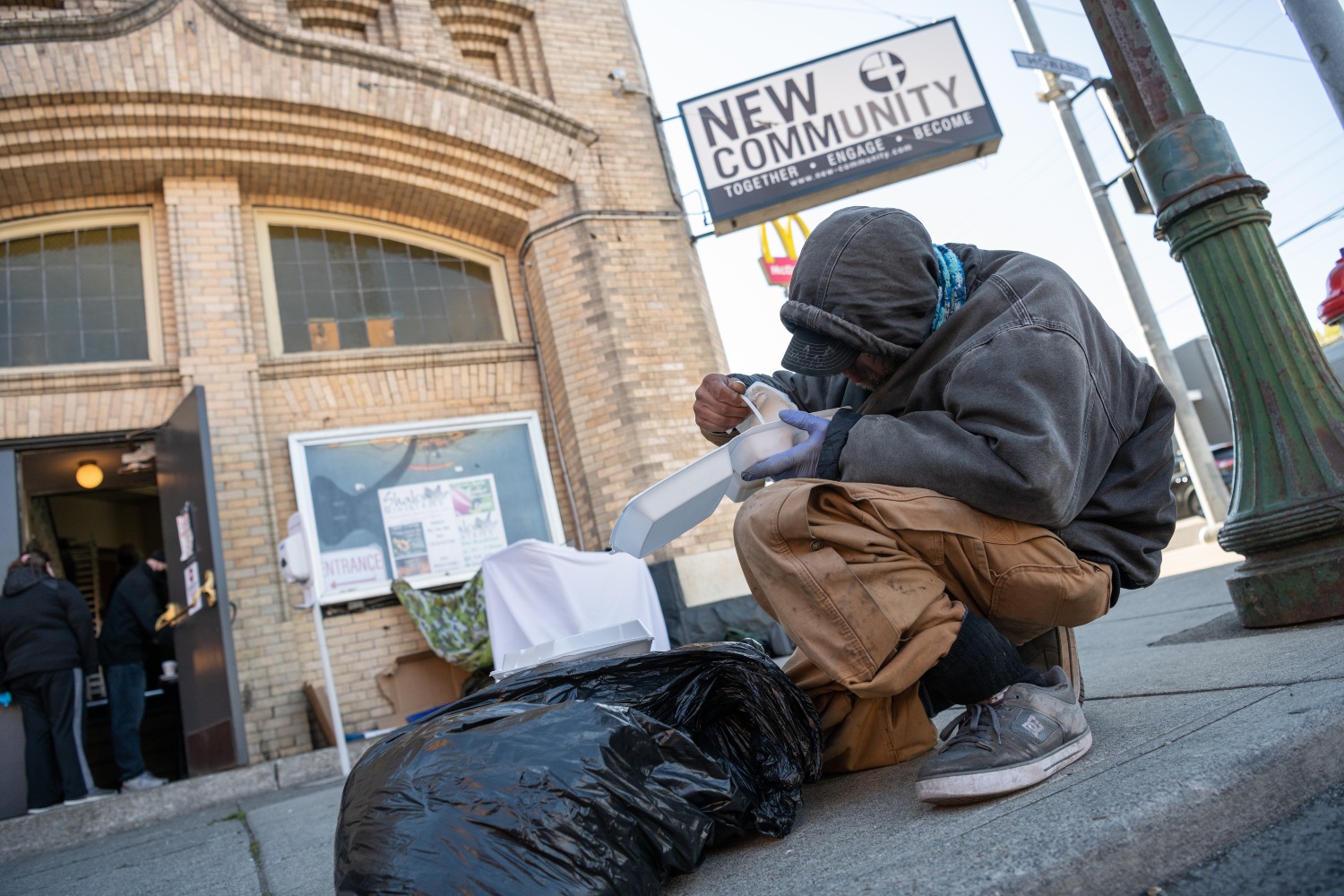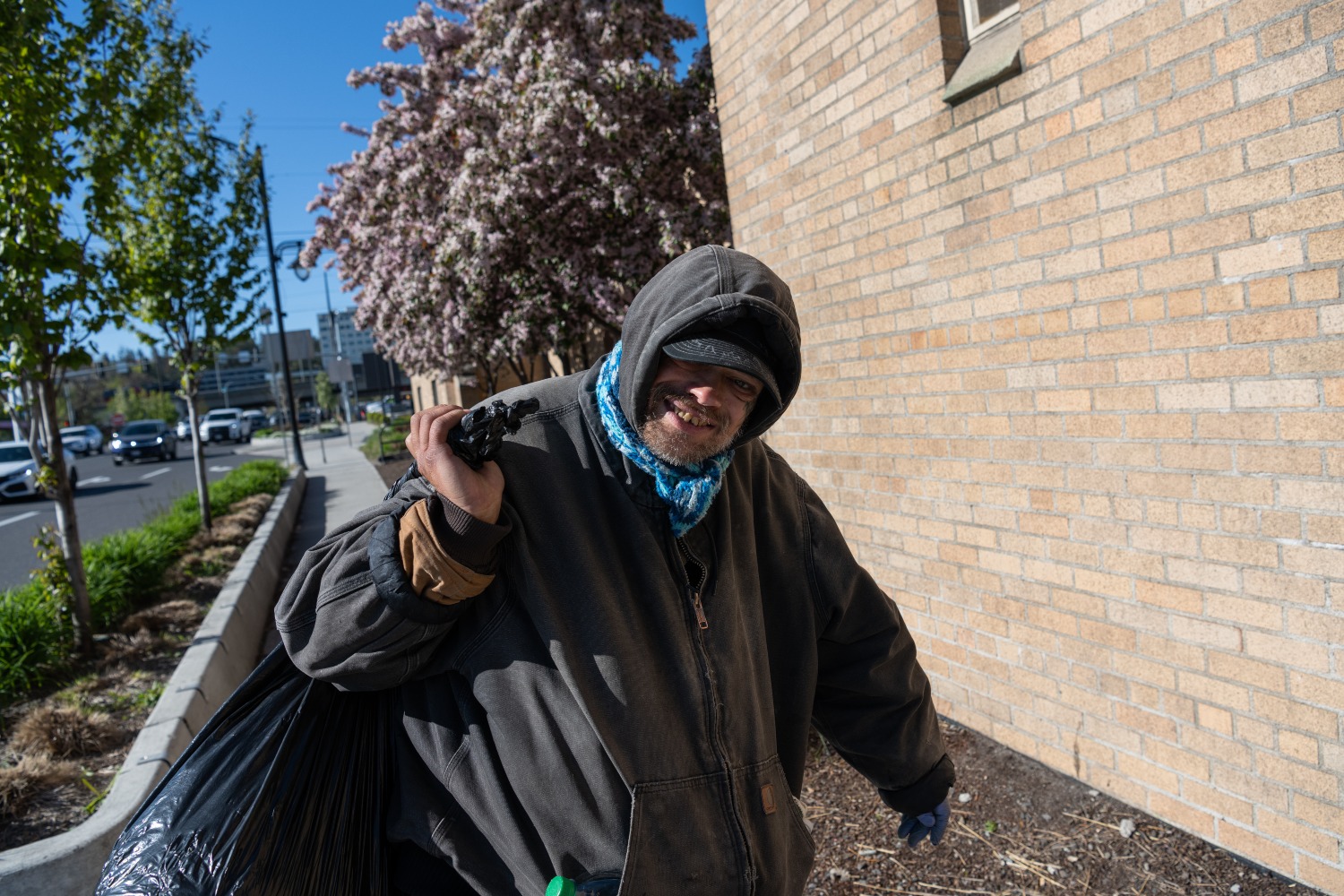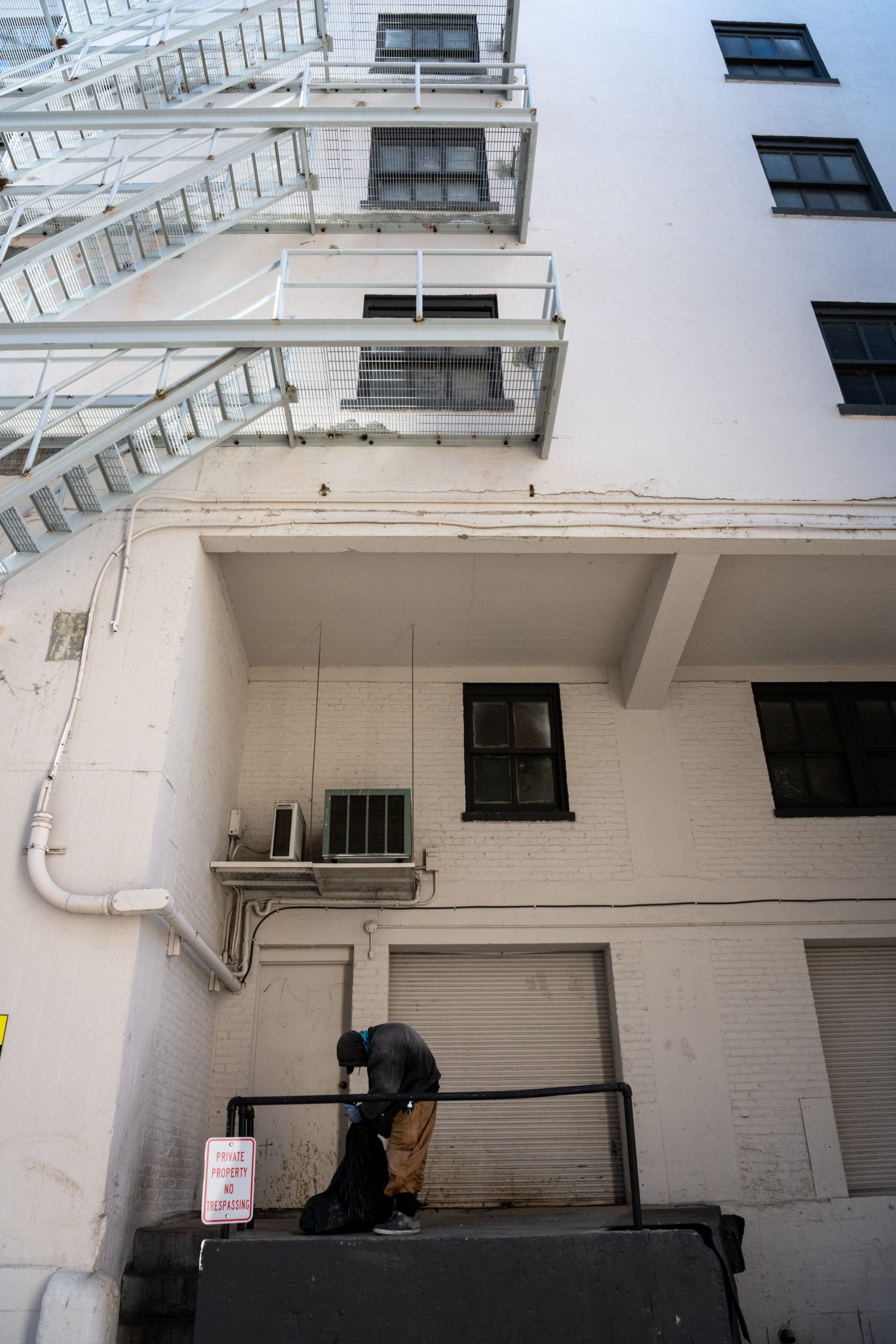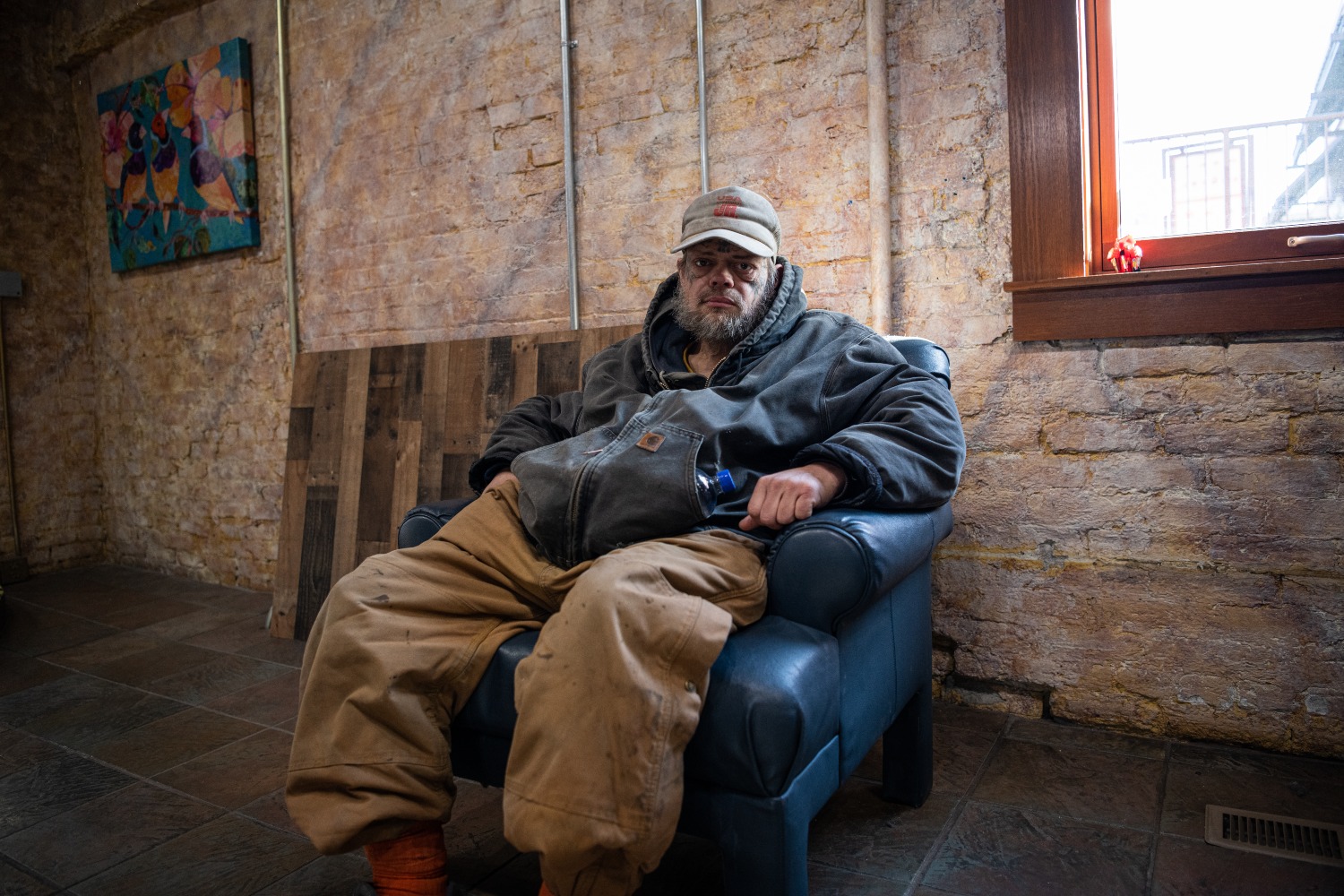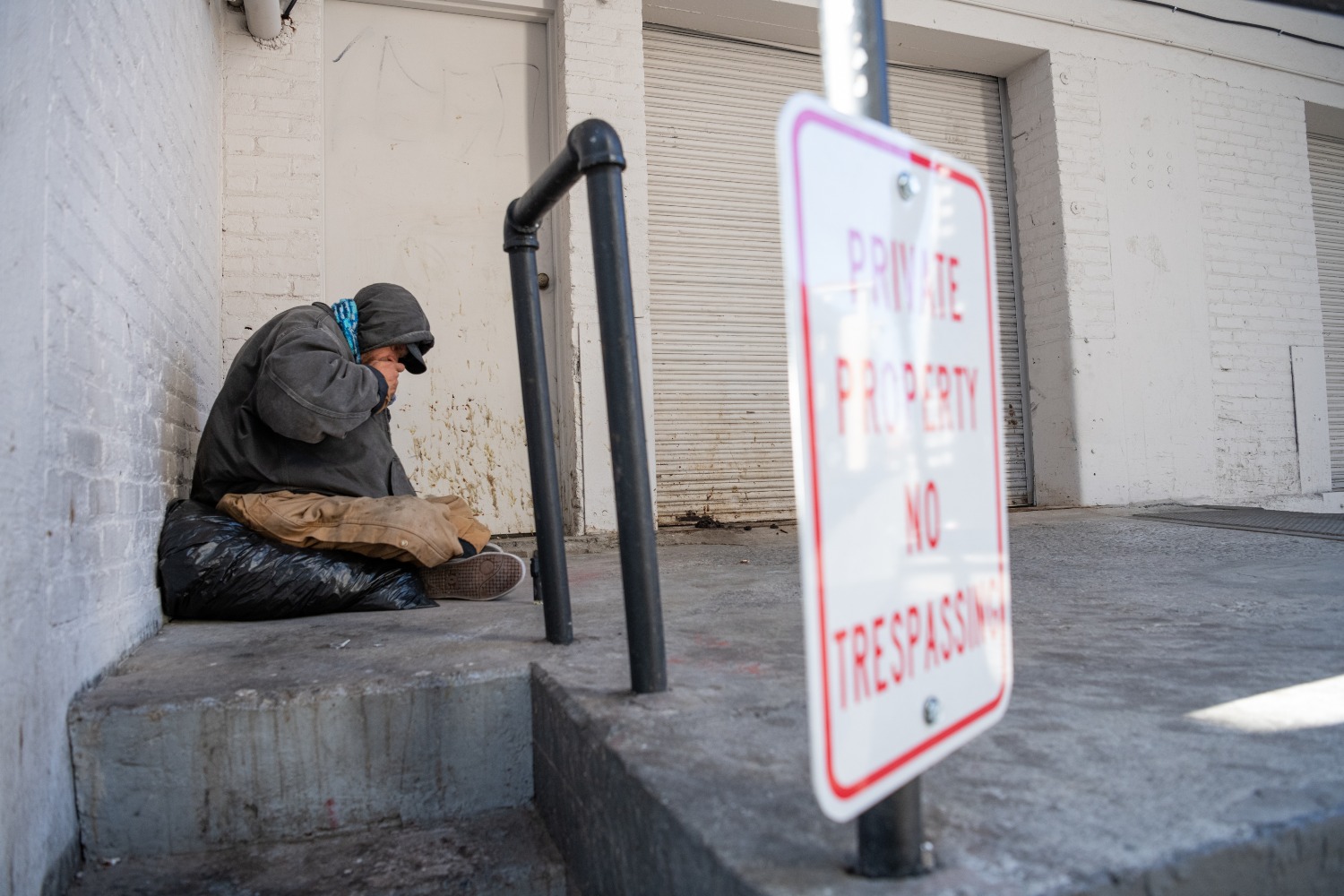People on the street who are resistant to shelters face a cruel choice: living rough in the cold or spending time behind bars
By Wilson Criscione / InvestigateWest
Published in partnership with The Guardian
Chris Carver waits in the courtroom for two hours before his name is called. Spokane Municipal Judge Mary Logan tells him to stand: “We’re dealing with your case now.”
Carver struggles to his feet. His beard is shabby. Branch-like tattoos wind around his eyes. He flashes a boyish grin through weary eyes. Logan faces him from the bench, an American flag draped behind her: “So, Mr. Carver, you want to waive your right to have an attorney represent you?”
“Yes, ma’am.”
“So that is your right, Mr. Carver, to do that,” the judge says. “I always wonder why, when you … qualify to have counsel assigned at no expense to you—”
Carver interrupts: “Because it’s a maximum penalty of a year in jail, and that ain’t nothing to me, ma’am.”
“I’m sorry, what?” the judge asks.
Carver continues: “I’m homeless, out there on the streets and everything. A year is nothing to me … I don’t know what else to do.”
The judge presses: “I would hate for you to think that jail is your home away from home.”
Carver shrugs: “I’m homeless out there, so…”
* * *
It was early February of a particularly cold winter in Spokane, in eastern Washington state, when Chris Carver decided he’d rather go to jail than ride out the next couple months on the streets. The charges against him were serious enough: criminal trespass, defecating in a church stairwell, malicious mischief for throwing a skateboard at a car that drove through the alley where he was sleeping. A public defender probably could have helped him avoid extended jail time.
But Carver’s choice — purposefully, knowingly torpedoing his chance at freedom — fails to shock those who regularly work with the chronically homeless. They say they have seen it many, many times. Only occasionally does it make the news. In January 2021, an Indiana man refused to leave a hospital until police booked him. In Mississippi, right before Christmas in 2019, a homeless man broke windows so he could spend the night in jail. And in 2018, a Washington man robbed his fourth bank in search of a long prison sentence.
Still, even assuming these are outlier cases in the spectrum of homelessness, people like Carver represent an urgent policy challenge increasingly facing communities across the country: How do cities deal with shelter-resistant, street-hardened people, the ones often demonized by politicians as living proof that America’s cities are dying?
No one believes that employing jails as temporary housing is smart or humane; nor does it make economic sense, as it’s more expensive than other options. The fact that it’s happening at all proves that something has gone horribly wrong, housing advocates say.
“It’s a national climate that has deprioritized housing, and it’s created incredibly cruel choices for folks who are experiencing any form of instability,” says Marc Dones, head of the King County Regional Homelessness Authority in Seattle.
It’s not just unfolding in places like Seattle and San Francisco. It’s now an issue confronting small and mid-size cities like Spokane (pop. 220,000), a place that had long been marketed — until recently — as an affordable city to raise a family. That’s no longer the case. Housing prices have skyrocketed by 60 percent in the last two years, and the community is divided over how to manage the sudden appearance of unhoused people occupying corners of its small, revitalized downtown.
The left-leaning City Council has pushed for more shelter space and housing that doesn’t require sobriety or treatment. Meanwhile, Mayor Nadine Woodward, a former local TV anchor and conservative, narrowly won office in 2019 after a tough-on-homeless campaign, in which she was critical of policies that she perceived as giving the homeless handouts with no accountability, pushing against merely “warehousing people and handing out sandwiches.”
And then there’s Carver, who lives the homelessness-to-jail cycle. He boasts that he is the “second-longest-homeless man in Spokane,” having survived on these streets for 25 years. He’s been constantly ticketed, arrested and jailed. Many of his claims are impossible to verify. But records show 16 convictions in Spokane alone; since his 18th birthday, he’s been charged with 43 crimes here and elsewhere. Most were nonviolent offenses: possession of marijuana, theft, panhandling. A few were for more violent crimes, like misdemeanor battery and fourth-degree assault. In 1999, he was sentenced to three months in jail for a misdemeanor charge of assaulting law enforcement personnel in Idaho. He spent a year in jail for a 2007 felony charge of riot with a deadly weapon.
Clearly, jail is not a deterrent in his case. And while the societal tussle over homelessness drones on, Carver and those like him get by any way they can — huddled under bridges, camped on sidewalks or, increasingly, locked behind bars.
* * *
I first meet Chris Carver last March, about a month after that day in Logan’s courtroom. He’s walking along the sidewalk in front of a gas station. He wears tan, insulated bib overalls and a coat stuffed with blankets. He lists to one side, the result of a debilitating leg injury. He collapses as I approach and then needs help to get back up.
I introduce myself and explain that I heard about him from Judge Logan. (I’d later listen to audio of the court hearing.) Carver and I make our way to a warm place to talk — a local recovery center where he can get free food. He scoops peanut butter from a jar with a plastic spoon.
With food and warmth, he becomes talkative and grins: That February day in the courtroom, in which he accepted a month behind bars on top of the one he’d already served, was far from the first time he sabotaged his own case. Jail, Carver tells me, is a logical choice during freezing winter months. When I ask him about shelters, he says he hates being crowded in with other people and doesn’t feel safe there. Social service workers say that’s a common complaint among those experiencing homelessness.
As we talk, Carver speaks casually about his criminal record, taking pride in the fact that most cops know him by his first name. But he says he wants to live his street life unbothered; police prevent him from doing that.
“I’m on one side,” he says, “and they’re on the other.”
He admits that life on the streets is lonely. Family? He says he hasn’t seen them in 30 years: “I wouldn’t even recognize them.”
Then he offers an explanation for his solitary life: He suffers from bipolar disorder, a mental health condition that causes extreme mood swings. And it’s so bad, he says, that he will black out only to realize he’s left someone laying in a pool of blood. He claims to have killed people like this, and says the state of Idaho once “tried to put him away for life” before it was determined he acted in self-defense.
Jail works, he says. He gets reliable meals, a cell to himself and is at no risk of hurting anyone else.
What about stable housing? A job?
Carver says there was a time when things were coming together. Five years ago, a pastor in Coeur d’Alene, Idaho — a 40-minute drive east from Spokane — helped Carver get a job at a steel beam factory and an apartment. Until one day he was hit by a car driven by a teenager being chased by police. Carver was hospitalized for months and has been homeless again ever since.
At least that’s the story he tells. Later, I discover that these stories — killing people, never seeing his family, being hit by a car during a police chase — are almost entirely untrue. It’s a persona he’s built to explain his circumstances to judges and service providers who wonder why he’s on the streets, and why he willingly gives up his freedom for a warm bed.
* * *
The story of a man voluntarily crippling his own freedom to get off the streets is nothing new to Dones, the head of the King County Regional Homelessness Authority in Seattle. It’s just another illustration of how this country fails to help the most vulnerable, street-hardened among us.
“I’ve heard this story many, many, many times,” Dones says. “I’m not aware of any academic paper on it. But those of us who work in housing and homelessness and public health know about it.”
The research that does exist on the issue comes from the United Kingdom. In 2010, a Sheffield Hallam University survey of 400 people living on the streets found that 30 percent had committed a minor crime with the intention of being taken into custody for the night. In 2020, a UK-funded watchdog — originally intending to study recidivism among those released into homelessness — discovered that many of the homeless people who were arrested voluntarily went back to jail.
“I kept reoffending to get put back inside as I couldn’t get accommodation,” one man quoted in the report said.
It’s not hard to find examples of people committing crimes just to get into jail.
Last Halloween, a homeless man in Longview, Washington, went vehicle prowling, trying to get police to throw him in jail. When they took him to a shelter instead, he left and committed a more serious crime: stealing a gun from a car. When police arrested him, he seemed relieved and told officers, “I’ve been trying to go to jail” to get warm, according to a police report obtained by InvestigateWest. He’s been there ever since on charges of vehicle prowling and theft of a firearm.
“It happens more than people admit it’s happening,” says Longview police Capt. Branden McNew. “We as police are familiar with that phenomenon.”
The longer someone is out on the streets, the more likely they are to end up in jail, whether they choose to or not.
In Seattle, for example, homeless people before the pandemic made up an estimated 1 percent of the city’s population but nearly 20 percent of its jail bookings, mostly for nonviolent crimes. National research from the Prison Policy Initiative shows that a person with a criminal history is up to 10 times more likely to experience homelessness than the general public. Being unsheltered, too, increases contacts with the police and the chances of being jailed.
That’s due in part to city policies that make basic acts of living on the street illegal: lying on a sidewalk, loitering, panhandling. Cities justify laws criminalizing homelessness by adding shelter space, arguing that anyone can choose to be off the streets and in shelter if they want.
But shelter beds seldom keep pace with need. And some people, like Carver, avoid shelters even when they are available. They say they feel unsafe and uncomfortable in the shelters, or they impose rules they can’t follow. During the COVID pandemic, sharing air space with that many other people became even more dangerous.
Homeless reform advocates say that understanding how often a person chooses jail is less important than understanding why it happens. In a basic sense, it isn’t a hard question to answer.
“Have you tried sleeping outside with nothing?” says Dones, the King County homelessness official. “It’s very possible to lose your extremities during a spring night outside, let alone a winter night.”
Truly understanding why someone would choose jail, however, means understanding how they arrived at that choice to begin with. That conversation, Dones says, must start with the recognition that the country is in a housing crisis that has priced people out of stable homes and forced them on to the streets.
“Homelessness is a housing problem,” Dones says. “It is not a problem of criminality or substance use or behavioral health.”
McNew, the Longview police captain, has mixed feelings about granting someone’s wish to be jailed. “You can’t arrest your way out of the homeless issue,” he says. Arresting the unhoused only serves to “perpetuate the behaviors by criminalizing these poor people.”
Yet sometimes, a homeless person commits a crime so serious that it can’t be ignored.
* * *
McNew was a detective four years ago when a call crackled over the police radio: A bank robbery was in progress just a half block away from the police station in Longview, a city of 37,000 tucked along the Columbia River in southwest Washington.
McNew rushed over prepared for the worst — hostages, gunshots, a chase. Instead, he found a 68-year-old man, bald and wearing thick glasses, waiting outside the bank. His name was Richard Gorton.
“It was so immediately apparent there was something unusual about it,” McNew says.
Gorton wanted to be arrested. And, as McNew quickly learned, he had robbed three banks in Bellingham, Washington, about 200 miles to the north, a few years earlier, all in hopes of going to prison. Each time, Gorton was calm, offering himself up to police willingly.
Today, Gorton is at the Stafford Creek Corrections Center in Aberdeen, where he’s serving a seven-year sentence for the 2018 robbery in Longview. He tells me he robbed the first bank in Bellingham back in 2014 because he thought he was going to lose his apartment at a public housing complex, which he paid for using money from Social Security. He was sentenced to three months behind bars and ordered into transitional housing. But as a convicted felon, it became harder to secure permanent housing. So he robbed another bank, then another — until he got three years in prison.
After the third robbery, he tried life on the streets. He tried the Union Gospel Mission in Spokane, but he couldn’t comply with the religious requirements. The same thing happened in Portland. So, just 10 days after his release from prison, he went to Longview to rob a bank again — this time getting the longer prison sentence he was seeking.
He says he feels bad about all of this. Not because he put any burden on the criminal justice system — that’s something he hadn’t considered — but because he was told that the last bank teller he robbed was distraught over the situation.
“I’ve come to be aware that hurt people often turn around and hurt other people,” Gorton says. “So this bank teller, who knows what road she goes down?”
Gorton grew up an only child in Golden, Colorado, in an upper-middle-class neighborhood. He attended a state college and over the years held a series of low-paying, clerical-type jobs. But he had trouble getting along with other people. In 2000, he says he was diagnosed with autism and began receiving disability benefits. He says he received $700 a month, which allowed him to live in public housing until 2014, when he began to fear he would lose those accommodations. He never considered seeking help with a social service organization, though, and he no longer had family to rely on. Once he robbed the first bank, his friends “disowned” him as well, he says.
“They couldn’t understand it,” he says. “They didn’t want anything to do with me.”
Gorton doesn’t know how he’ll live when he gets out of prison. He says he doesn’t want to commit more crimes or hurt more people, so he’s preparing for the scenario he’s been trying to avoid this entire time:
“I think I’m going to try my best to endure homelessness.”
* * *
On a cold but sunny April morning, Carver wakes up under the shadow of Spokane’s tallest buildings, in an alley behind the Davenport Hotel Tower, part of the city’s flagship luxury hotel collection.
He slumps against a wall at his camp, a cement loading area under a covered staircase, tucked behind a “No Trespassing” sign. Trains rattle along tracks two blocks away. He’s surrounded by his own feces. A blanket and a piece of cardboard cushion him from the cement. He has no tent.
“Tents,” he says, “are targets for cops.”
As a city street-cleanup crew pulls up nearby, he rolls up his blankets and packs them into a torn-up trash bag, pressing the air out so he can stuff it under his coat and insulated overalls. But his hands — already cracked and bleeding from the dry, cold air — are stiff with pain. Once the blankets are secure, he takes wincing steps down to the alley, still whimpering.
He’s headed a few blocks south, where Shalom Ministries gives him three to-go boxes of pancakes and oatmeal. After passing by other homeless people, he complains about the new generation of homeless. Carver doesn’t understand how they rip each other off, beat each other up, even kill each other — but still sometimes get high together.
Carver gets high on his own and sticks to weed — meth only “once in a blue moon” — because he’s afraid of needles. He says he’s careful to avoid eye contact with anyone on the street for fear they might attack or rob him. He says it’s been years since he’s had a relationship with a woman; they come crying to him when their boyfriends beat them up, he says, but always end up going back to them.
It’s a typical morning for Carver. He wakes up miserable. He searches for food, a bathroom, a place to rest in peace. It seems that everywhere he goes, “No Trespassing” signs remind him that he’s not supposed to be there. Some days, like today, he ends up at Compassionate Addiction Treatment, a local recovery center that lets him inside even though he’s not a patient. He limps there with his to-go boxes, bending to pick up any penny he sees on the sidewalk.
Out front, a woman asks around for a lighter. She sees Carver.
“Oh, Chris, I know you have a lighter,” she says.
“Here you go,” Carver says.
She hands Carver a cigarette in exchange. He is polite and friendly, but when she leaves, he sticks out his tongue in disgust.
“Ugh, menthols.”
Inside the treatment center, he takes a chair at a dining table used for group therapy and opens his boxes of food. The oatmeal is so sticky it almost breaks his plastic fork. The pancakes are burned. He tosses out the little boxes of raisins that came with the meal.
He gets up to grab some cookies and coffee, loading up as much as he can. A woman named Rebecca is in his seat when he comes back.
“Excuse me, Rebecca, you’re in my seat,” he says.
She moves. But when he gets up for another cookie, she takes his seat again, even though every other chair at the table is empty. He remains polite.
“Rebecca, you’re in my seat,” he says. “Can you please move?”
She moves again. Finally settled, Carver smothers his pancakes with syrup, his head bent low, studying how the syrup drips over the cakes. He takes a sugar cookie and dips it in his coffee, leaving it in a long time until he deems it ready to take out. He ignores the people shuffling in and out around him. It takes him 30 minutes to finish his food. When he’s done, he trades with another homeless man the cigarette he got earlier for a half carton of milk to wash it all down.
A group session is about to start and Carver leaves, back out into the freezing weather. It’s cold days like this that make jail an appealing option, he says. There, at least, he doesn’t have to trek across town to have a meal in peace.
I ask which he prefers in the winter: jail, or life on the streets.
He thinks about it.
“Jail,” he says. Then, a qualifier: “If I was able to smoke weed inside.”
* * *
Sarah Gillespie, an associate vice president at the Urban Institute, a D.C.-based think tank, cautions care when using the word “choice” when it comes to people who are homeless. As someone who studies the issue, Gillespie finds herself in a constant battle with what she calls the “myth” that living on the streets or landing in jail is a choice. If given the chance to have housing or not, the vast majority of people would choose housing, her studies have found.
“We do know what the solutions are,” Gillespie says. “It’s really about, what is it going to take to get communities on board, to scale the solution to the level needed?”
She says the most effective way to end the homelessness-to-jail cycle is also the most obvious: give people housing. An ambitious “housing first” approach, a research-backed practice of giving people a free or affordable place to live without requiring sobriety, is what’s helped Houston make great strides in addressing homelessness. Housing advocates say that option can be a money-saver compared with the cost of shelters, police services and jail.
There is no widely accepted estimate on how much it would cost to provide stable housing for every person in the U.S. who needs assistance. But an Urban Institute analysis of the federal Housing Voucher Program, which assists low-income households struggling with rent, found that only one in five renters who qualify for assistance receive it. Expanding it to assist all who qualify — an additional 19.7 million people — would cost the U.S. an estimated $62 billion per year.
Gillespie cites a Denver-based program that provided free or heavily subsidized housing to chronically homeless people who had the most extended time on the streets and most frequent contact with police — people like Chris Carver. Renters could still use drugs or alcohol and keep their housing, but there were mental health and drug addiction services available for them.
After three years, nearly 80 percent of people in the Denver program remained in stable housing. That’s proof, Gillespie argues, that even most chronically homeless people would accept a home if it were available. Most notably, arrests for people who were provided housing through the program dropped by 40 percent compared with a control group.
As for cost, such direct housing could actually save money. Housing through the program cost about $15,000 to $16,000 per person per year. But the Urban Institute found that half of those costs were offset by less need for other services such as street sweeps, shelters, police response and emergency room visits. That makes housing a better investment than the current patchwork of services, Gillespie argues: “It’s just a huge cost to allow this cycle of jail, homelessness and emergency services to continue.”
Dones, with the homelessness authority in King County, agrees that providing housing is the best way to help people like Carver. Adequate emergency shelter space is vital, but many people simply won’t use it. Some of the dollars spent on adding shelters could be put to better use by investing in housing. Even providing services to so-called “tent cities” can get expensive. In San Francisco, a homeless encampment run by the city cost an estimated $60,000 per year per tent.
Dones advocates the public purchase of buildings, such as former hotels that can be quickly transformed into affordable housing.
“It doesn’t make sense to me that we would spend the amount of money that we do on some of these other solutions,” Dones says. “And the argument that we need something for people to be in for five years while the housing gets built to me simply doesn’t pass a good sniff test.”
Meanwhile, what’s far more costly than providing housing is allowing people who are homeless to go to jail. It costs an average of $47,057 nationwide to jail a person for a year, or $33,274 to put a person in prison for a year, according to the nonprofit Vera Institute of Justice.
That’s why experts like Cathy Alderman, public policy officer for the Colorado Coalition for the Homeless, argue that programs like Denver’s need to be scaled up to fit the need. Each time a person chooses jail, it highlights a broken system, she says.
“It’s a policy, a political and a funding failure,” Alderman says.
As those policy debates stall any real progress, people like Carver continue to churn through sorry cycles.
* * *
Betty Arford’s home in Post Falls, Idaho, is painted off-white and the front lawn shines a bright green. The tidy home is surrounded by the sound of neighborhood kids playing basketball outside, dogs barking, lawn mowers humming. It’s a stark contrast from the life of Chris Carver, Arford’s middle child, 25 miles away on the streets of Spokane.
Arford, 70, says she last talked to her son five years ago, when he was admitted to the hospital with a broken right hip and femur that required emergency surgery. But he hadn’t been hit by a teenager trying to evade police, as he now tells people. Instead, he fell off a bicycle while swerving around a bush, snapping his leg. Soon after the surgery, against medical advice, Carver left the hospital with fresh staples in his skin, taking a wheelchair with him. The reason he gave her? He couldn’t smoke weed.
That reality also runs contrary to Carver’s oft-repeated claim that he hasn’t seen his family in 30 years. In fact, Arford — who ran a mental health clinic with her husband for seven years — says that she spent years trying to help her son, to no end. Now she keeps tabs on where he is by checking the local jail logs.
“We don’t know what to do for him,” she says. “My dread is that some day we’ll get a call that he’s been killed.”
Carver grew up in a Christian family, with an older sister and younger brother in a big house on two acres of land in nearby Kellogg, a small town that’s home to a popular ski resort. His father, Gary Carver, was an electrician at the nearby Bunker Hill mine. On weekends, the family went camping.
Carver always had problems in school, the likely result of severe ADHD, Arford says. He would annoy the other kids who, in turn, would bully him. He’d often run away from school and not come home until dinner. She home-schooled him for a couple years of elementary school before enrolling him in middle school. But her son just “couldn’t function” in that environment, and Arford couldn’t get the special education support he needed. She went to the district superintendent. She wrote her U.S. senators. She tried an alternative school. For about six months, Carver had a full-time teacher working exclusively with him until he went back to a traditional school. None of it worked.
As a teenager, Carver was in trouble more and more often. He broke into homes. He stole. He lied. The bullying from other kids also grew worse. When he was 14, Arford says, a few neighborhood kids decided to give him a “hot foot,” dousing his feet with charcoal lighter fluid and setting fire to them. It left bad burns on his legs.
Arford doesn’t know if her son has ever been diagnosed with bipolar disorder, as Carver claims, but it wouldn’t surprise her. She’s convinced he’s not a violent person. He just has trouble with the truth. “He would tell a lie when the truth would suit him better,” she says. “It starts as a lie and then he says it so often that it becomes real.”
Carver, his mom says, acted on impulse, never considering consequences. If he had any money, he’d blow it right away. The one thing she remembers her son enjoying was fishing — something he liked to do alone. But she couldn’t trust what he’d do on his way back home.
He turned 18, and the arrests started racking up: burglary, theft, misdemeanor battery. He was frequently busted for possession of marijuana, although Arford says he never got into hard drugs. She helped him get Social Security based on his ADHD diagnosis to pay rent on his own apartments. But he accused her of stealing his money when she managed it; in his own hands, it was soon spent on other things.
“He has no concept of money,” Alford says. “He’d go out and spend all of it and be out within the first couple days. He’s had a lot of people offer him housing or treatment. He either doesn’t follow through, or he does and then gets in trouble where he’s at.”
Arford doesn’t know how to help her son. She still wonders if things would have been different if there was more understanding of a child like him when he was in school. He’s almost 50 now, and has lived most of his life on the streets or in jail. She thinks he needs institutional mental health treatment. Legally, he can’t be institutionalized unless he were deemed a threat to himself or others, and America long ago decided it is cruel to institutionalize someone who is not a threat against their will. Still, Arford believes her son has been happiest when he was in a mental health hospital, or in an extended stay behind bars. Carver thrives in a more restrictive, regulated environment, she says.
Maybe, she wonders, her son knows that about himself.
* * *
Sitting on the front steps of a church in downtown Spokane, I ask Carver what he wants for himself. If he could shape the next few years of his life, what would it look like?
“This,” he replies. “Until something comes up.”
“What would come up?” I ask.
He doesn’t know.
He mentions that a friend is in housing where he can smoke weed and not be bothered. We’re sitting across the street from an apartment complex run by Catholic Charities of Eastern Washington. It’s part of the organization’s “housing first” strategy in Spokane, which has drawn debate locally over the idea of giving housing away with no accountability.
“Do you want housing?” I ask.
“It depends on what it is,” he says.
He suddenly changes the subject: “Do you mind if I smoke weed?”
He’s not allowed to smoke on the grounds of the treatment center, so he goes across the block to the steps of a church. He ignores the “No Trespassing” sign posted there. After his third hit, he exhales the smoke, and his world seems to slow down and focus. Even his speech — usually a slurred mumble — is clearer.
Unprompted, he tells a story about how it snowed on his 13th birthday — July 9, 1986. It’s another reflection on his place in an unforgiving world: Snow falls on his birthday, when it was supposed to be warm and sunny. It’s also untrue, according to weather records.
As the story goes, Carver sees the snow, and he goes into his mom’s room and tells her.
“Mom, it’s snowing in July,” he says.
She doesn’t believe him.
“No, look,” he begs.
Then, as Carver recalls it, his mom looks outside and sees that he’s right. She’s just as shocked as he is. It’s snowing on his birthday, of all days.
“It’s snowing,” she agrees. “In July.”
Carver smiles as he finishes this story, and with police cruisers circling the area, he gathers his coat and drags himself into an alley.
FEATURED IMAGE: Chris Carver is almost 50 and has lived most of his life on the streets or in jail. (Erick Doxey/InvestigateWest)
InvestigateWest (invw.org) is an independent news nonprofit dedicated to investigative journalism in the Pacific Northwest. Visit invw.org/newsletters to sign up for weekly updates.

